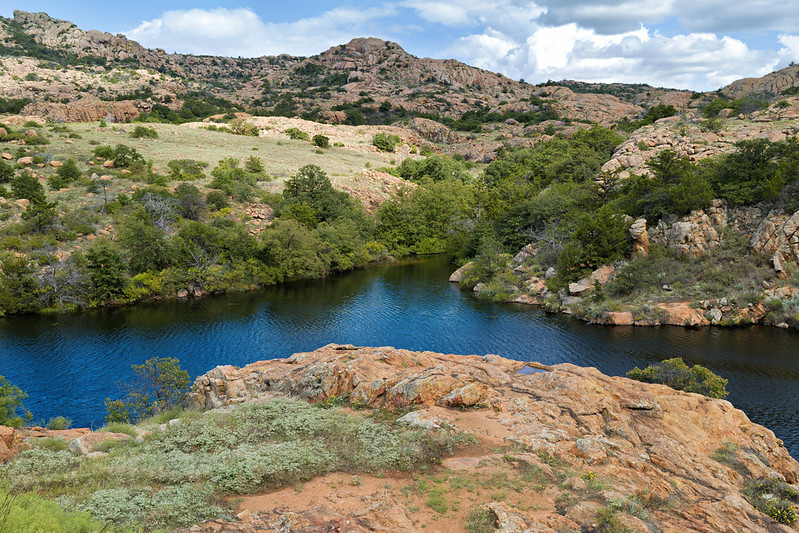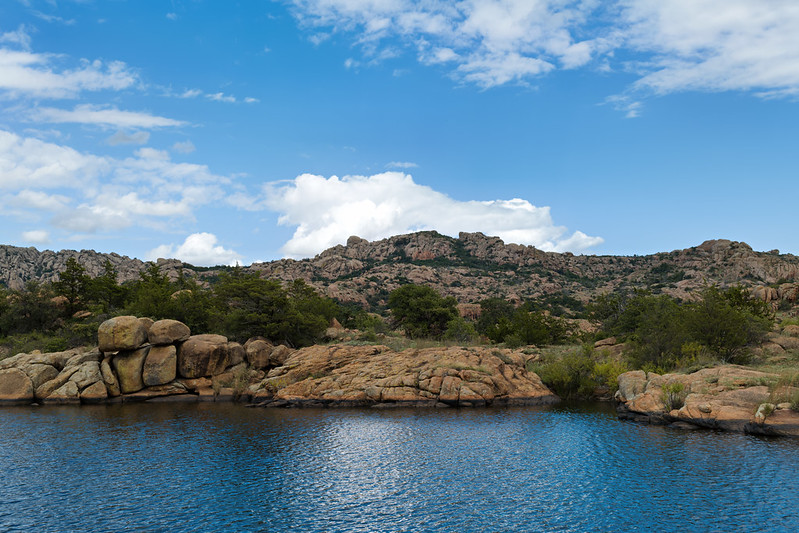This past Sunday, September 21, I set out for a camping trip at the Wichita Mountains Wildlife Refuge in Oklahoma. My main goal was to view and photograph elk. Last September, the bulls were everywhere (Elk Encounters in the Wichita Mountains Wildlife Refuge). This year, luck was not on my side. I caught a few glimpses of cow elk and even heard the haunting bugle of a bulls echoing through the canyons, but the photo opportunity never came. I did manage to photograph a cow elk, which I’ll share in another post. While those elk images will have to wait, I want to begin this series by sharing the striking landscapes I captured around Post Oak Lake and Treasure Lake.


Wildlife Notes from Wichita Mountains Wildlife Refuge Lakes
The Wichita Mountains blend rolling prairie, granite outcrops, and small blue lakes into a patchwork of habitats. Post Oak Lake and Treasure Lake sit close together near the old Job Corps Center, which is now being torn down. They provide a quiet retreat where wildlife comes to drink, rest, and move between the rocky ridges.
Even though bull elk eluded my camera this time, the lakeshores were alive with other signs of life. Birds worked the edges of the water, dragonflies hovered above the shallows, and the occasional turtle slipped into the lake with a quick splash. September marks the elk rut, so even when the animals remain hidden, their calls carry across the stone hills, reminding you that the refuge is far from silent.
Photography Notes at Wichita Mountains Wildlife Refuge Lakes
Both landscapes were photographed with my Fujifilm X100VI and its fixed 23 mm f/2.0 lens. It is easy to carry on long hikes, yet still brings home detail that does justice to stone and sky.
At Post Oak Lake, I stood on a granite ledge overlooking the water. Shooting at f/8 with a shutter speed of 1/250, I tried to hold the curve of the shoreline as a natural guide through the frame. The reflection of the blue sky ran deep against the orange tones of the rock.
At Treasure Lake, I shot from lower ground, closer to the waterline. With f/11 and a shutter speed of 1/200, I pulled the near boulders into sharp focus while keeping the distant ridges clear. Scattered clouds drifted across the open sky, adding a sense of depth and movement to the stillness of the lake.
Both images reminded me that in the refuge, the light shifts quickly. A small change in position or timing can turn an ordinary scene into something layered and alive.
Map Puzzles and Naming Quirks
I’ve always been a little puzzled by the naming of these lakes. The U.S. Department of Interior maps and Google Maps don’t fully agree. For example, Google shows Post Oak Creek flowing out of Treasure Lake, which seems backward given the names. Whether you call them Post Oak or Treasure, the scenery remains the same, rugged, layered, and distinctly Oklahoman.
Trail Tips for Visiting the Lakes
The terrain around these lakes is rocky and exposed, so start early and carry water. Slabs of granite hold heat, and shaded areas can be few and far between. After rain, lichens and moss patches become slick, so step carefully. Wildlife always has the right of way here, whether it’s bison on the trail or elk approaching the water’s edge. Move slowly, and let the place set the pace.
